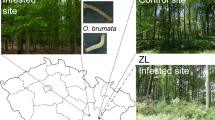Summary
The Syrian Woodpecker, Picoides syriacus, acquires its food by excavating, probing, gleaning and fly-catching (Fig. 1). The food-acquisition is carried out from ground level to the crown layer of trees and beyond (Fig. 2).
In an ecological sense the Syrian Woodpecker occupies an intermediate position between the Great Spotted and the Middle Spotted Woodpecker (Picoides major and medius). That is true for food-acquisition since it excavates more than medius and less than major whilst probing more than major and less than medius. The species is also intermediate in the choise of base from which foraging is done. Great Spotted Woodpeckers are found frequently on thin twigs and Middle Spotted Woodpeckers on thick stems.
Between Great Spotted and Syrian Woodpecker there exist interspecific territoriality. Both are neutral with respect to the Middle Spotted Woodpecker. In spite of strong competition for nesting holes and frequent aggression the territories of Syrian Woodpecker and Starling (Sturnus vulgaris) overlap. These findings are discussed.
Similar content being viewed by others
Literatur
Bock, C.E., Hodow, H.H., Somers, P.: Relations between Lewis and Red-headed Woodpeckers in South-eastern Colorado. Wilson Bull. 83, 237–248 (1971)
Bodenstein, G., Kroymann, B.: Die Ergebnisse der Mazedonie--Exkursion der Ornithologischen Gesellschaft in Bayern im Mai/Juni 1966. Anz. orn. Ges. Bayern 8, 134–157 (1967).
Cody M.L.: Convergent characteristics in sympatric species. Condor 71, 222–239 (1969).
Conrads, K.: Die Spechte in Westfalen-Lippe. 18. Ber. Naturwiss. Verein Bielefeld, 25–115 (1967).
Edington, J.M., Edington, M.A.: Spatial patterns and habitat partition in the breeding birds of an upland wood. J. anim. Ecol. 41, 331–357 (1972).
Freitag, H.: Einführung in die Biogeographie von Mitteleuropa. Stuttgart: Fischer 1962.
Hogstad, O.: Stratification in winter feeding of the Great Spotted Woodpecker Dendrocopos major and the Three-toed Woodpecker Picoides tridactylus. Orn. Scand. 2, 143–146 (1971).
Jackson, J.A.: A quantitative study of the foraging ecology of downy woodpeckers. Ecology 51, 318–323 (1970).
Jordans, A.v.: Ein Beitrag zur Kenntnis der Vogelwelt Bulgariens. Mitt. kgl. naturw. Inst. Sofia 13, 49–152 (1940).
Keve, I.: Einige Erfahrungen über die Beziehungen der eingedrungenen Vogelarten zu der einheimischen Vogelfauna. Vorträge II. Konf. Tschechoslow. Orn. Ges. Prag 1962, 101–108 (1962).
Keve, I.: Percularities of range expansion of three European bird species. Proc. XIII. Int. Orn. Kongr. Ithaca 1962, 1124–1127 (1963).
Kumerloeve, H.: Zur Kenntnis der Avifauna Kleinasiens. Bonn. zool. Beitr. 12, Sonderheft (1961).
Kumerloeve, H.: Zur Avifauna des Van Gölü-und Hakk<ari- Gebietes (E/SE Kleinasien). Istanbul Üniv. fen Fak. Mecmuasi 34, 245–312 (1969).
Kumerloeve, H.: Zur Kenntnis der Avifauna Kleinasiens in der europäischen Türkei (Ergänzungen—Hinweise—Fragestellungen). Istanbul Üniv. fen Fak. Mecmuasi 35, 85–160 (1970).
Leiber, A.: Vergleichende Anatomie der Spechtzunge. Zoologica 6, (51) (1907).
Löhrl, H.: Der Star als Bruthöhlenkonkurrent. Vogelwelt 77, 47–50 (1956).
Makatsch, W.: Die Vogelwelt Mazedoniens. Leipzig: Akad. Verlagsgesellschaft 1950.
Murray, B.G.: The ecological consequences of interspecific territorial behavior in birds. Ecology 52, 414–423 (1971).
Nowak, E.: The range expansion of animals and its causes [Poln. mit Engl. Summ.]. Zeszyty Naukowe 3, 1–225 (1971).
Pielou, E.C.: Shannon's formula as a measure of specific diversity: its use and misuse. Amer. Naturalist 100, 463–465 (1966).
Radermacher, W.: Beobachtungen an Spechten. Orn. Mitt. 6, 179–183 (1971).
Reiser, O.: Materialien zu einer Ornis Balcanica. II. Wien: Gerold 1894.
Rüger, A.: Funktionell-anatomische Untersuchungen an Spechten. Diss. Math. Naturwiss. Fak. Univ. Kiel 1971.
Ruge, K.: Beobachtungen am Blutspecht Dendrocopos syriacus im Burgenland. Vogelwelt 90, 201–223 (1969a).
Ruge, K.: Zur Biologie des Dreizehenspechtes Picoides tridactylus L. 2. Beobachtungen zur Mauser. Orn. Beob. 66, 42–54 (1969b).
Schüz, E.: Vögel von Teheran und von Bagdad. Vogelwelt 78, 73–82 (1957).
Selander, R.K.: Sexual dimorphism and differential niche utilization in birds. Condor 68, 113–151 (1966).
Sielmann, H. Das Jahr mit den Spechten. Berlin: Ullstein 1958.
Slivka, L: Von der Biologie des Blutspechts, Dendrocopos syriacus balcanicus, und seinen Beziehungen zu den Staten, Sturnus vulgaris. Larus 9–10, 48–70 (1957).
Stresemann, E. V.: Die mauser der Vögel. J. Ornith. 107, Sonderheft (1966).
Voous, K.H.: On the history of the distribution of the genus Dendrocopos. Limosa 20, 1–142 (1947).
Voous, K.H.: Die Vogelwelt Europas. Hamburg-Berlin: Parey 1962.
Winkler, H.: Das Schmiedeverhalten des Blutspechtes (Dendrocopos syriacus). Egretta 10/2 1–8 (1968).
Winkler, H.: Die artliche Isolation des Blutspechtes, Picoides (Dendrocopos syriacus). Egretta 14, 1–20 (1971).
Winkler, H.: Beiträge zur Ethologie des Blutspechts (Dendrocopos syriacus). Das nicht-reproduktive Verhalten. Z. Tierpsychol. 31, 300–325 (1972).
Author information
Authors and Affiliations
Rights and permissions
About this article
Cite this article
Winkler, H. Nahrungserwerb und Konkurrenz des Blutspechts, Picoides (Dendrocopos) syriacus . Oecologia 12, 193–208 (1973). https://doi.org/10.1007/BF00345517
Received:
Issue Date:
DOI: https://doi.org/10.1007/BF00345517




